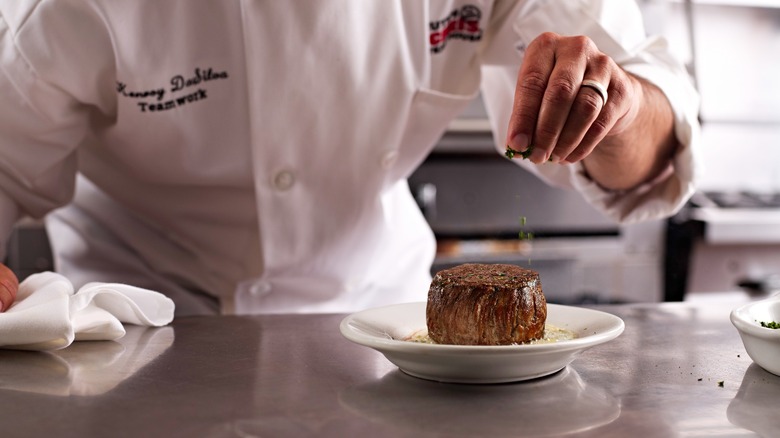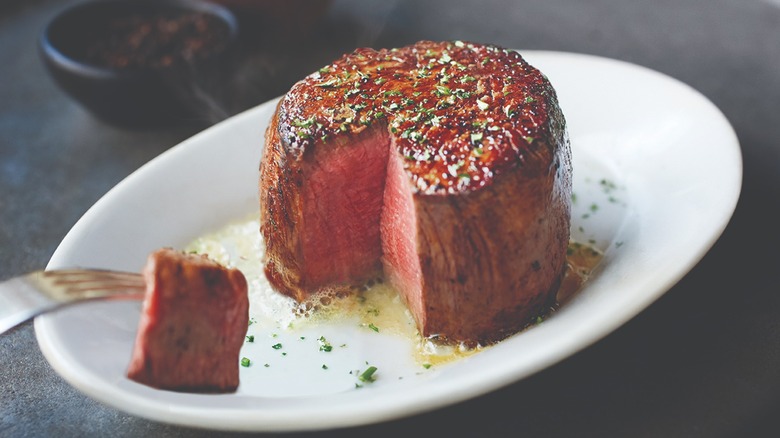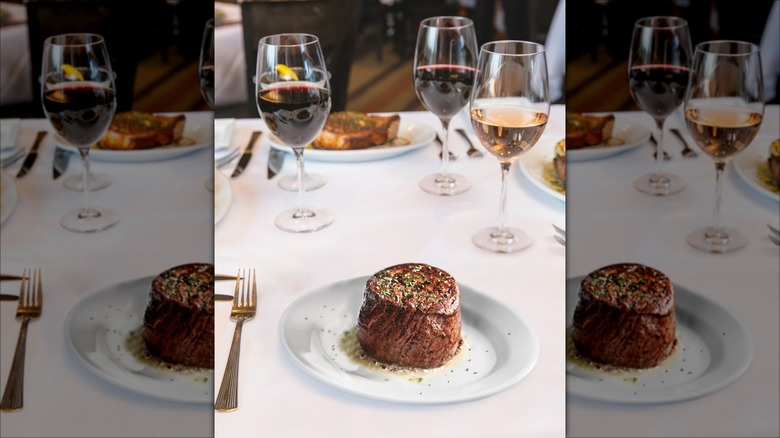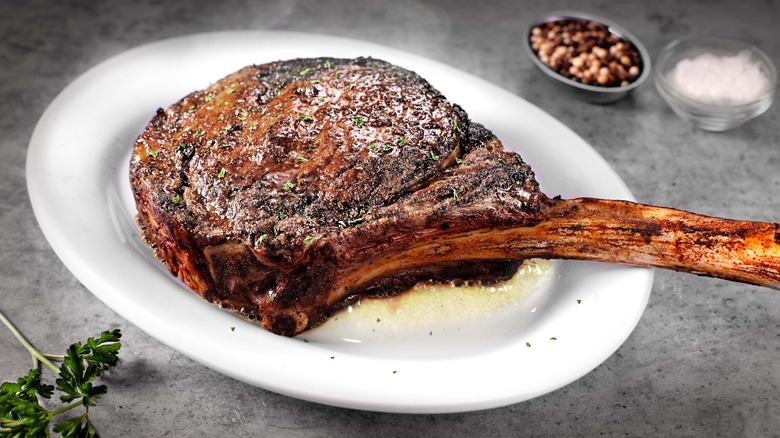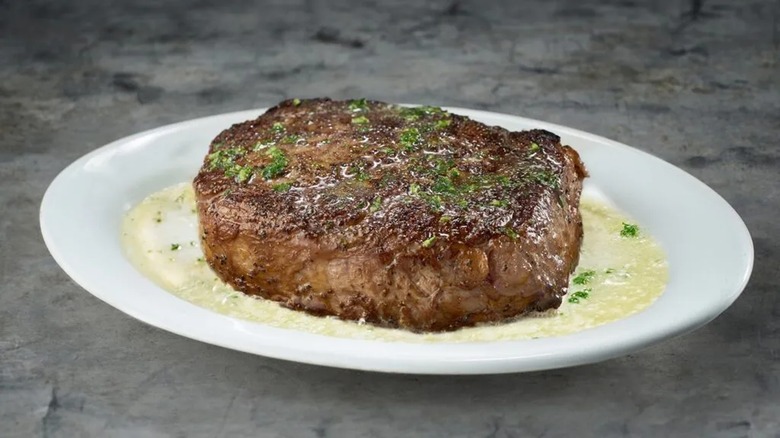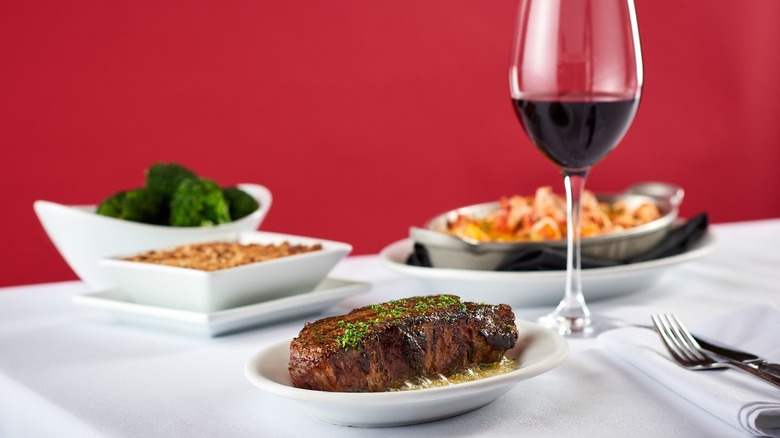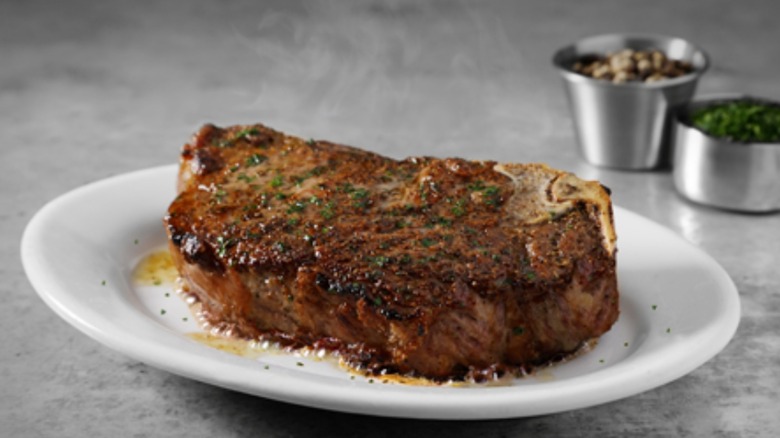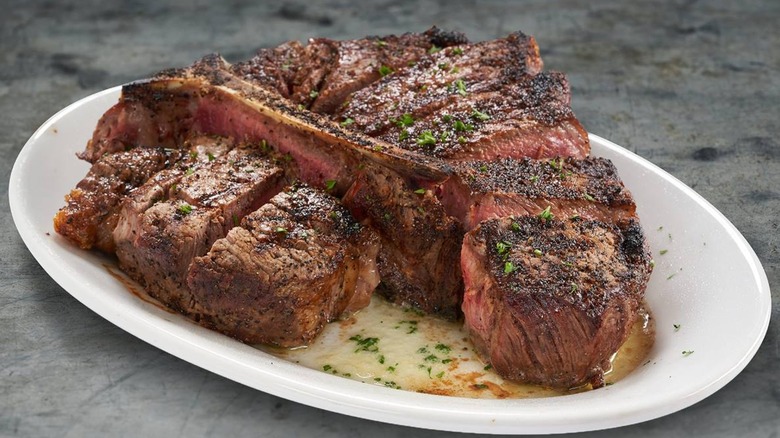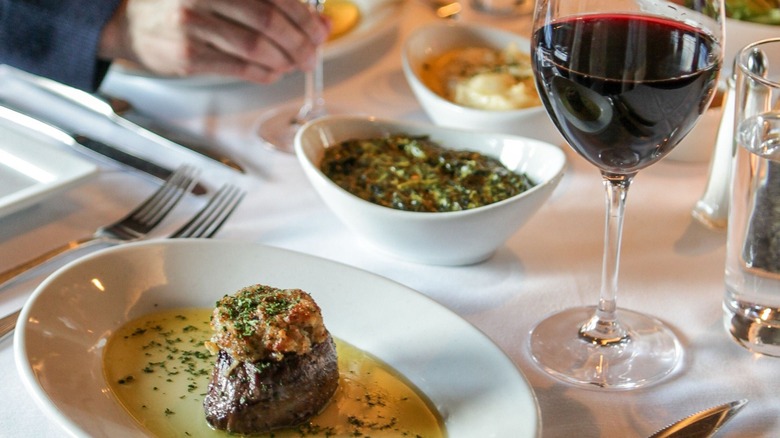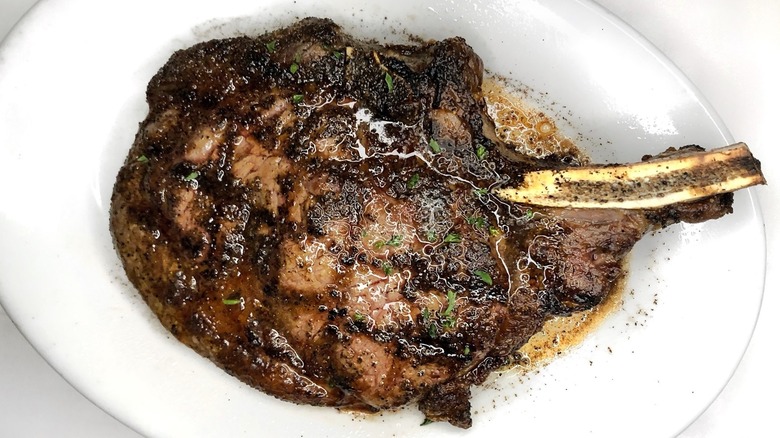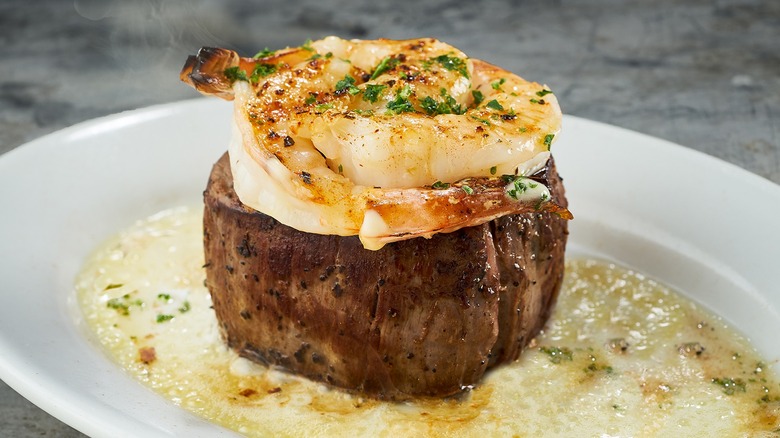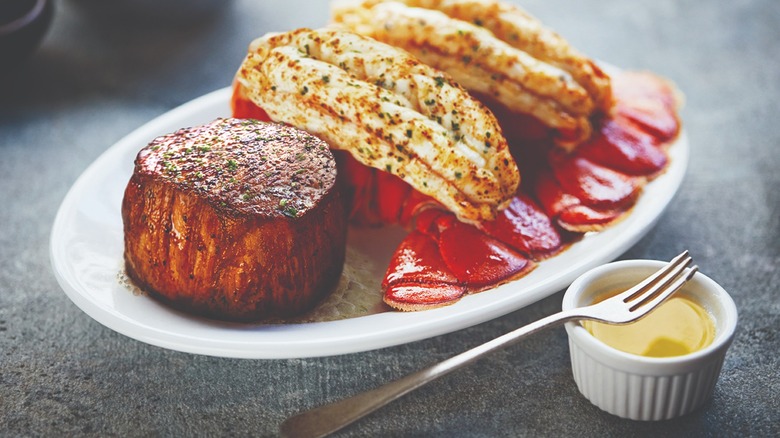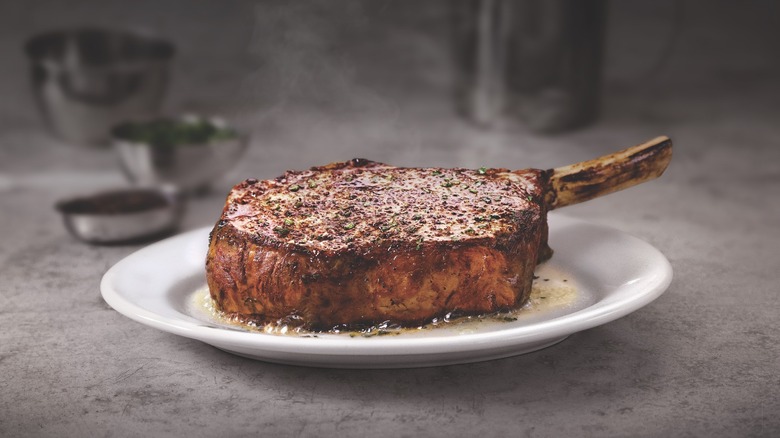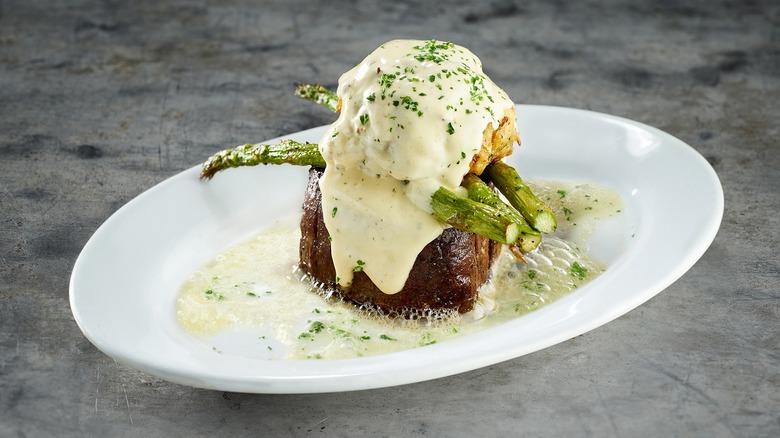How To Choose The Perfect Steak Cut At Ruth's Chris Steak House
When you visit Ruth's Chris Steak House, one of the most daunting tasks can be knowing which steak cut to choose. With so many cuts at different price points, the choice may not be an obvious one. Your main choices are Filets, New York Strips, Ribeyes, Bone-In Filets, Bone-In New York Strips, Cowboy Ribeyes, T-Bones, Porterhouses, and Tomahawk Ribeyes. But which one is right for you?
To get recommendations, we consulted Executive Chef Abdiel Aleman at Ruth's Chris Steak House. He has worked at Ruth's Chris for over 30 years and was able to give us some expert insight about the differences between the steaks the chain offers. He said, "You can't go wrong with one of our steaks, and if you're uncertain of what to order, our servers are always happy to help you decide." This guide will also help you make a more confident decision next time you're trying to decide which steak to order at Ruth's Chris.
Choose your Ruth's Chris Steak House steak cut based on price
With over $100 difference between some steak prices at Ruth's Chris, price is likely on your mind. While there are plenty of ways to choose steak, price may be important if you're on a budget, looking for deals, or want to impress.
There are excellent options if you're on a budget. The cheapest option is the 6-ounce Filet in the Steak Frites on the lunch menu, which comes with shoestring french fries, a starter, and dessert for $36. When you're ordering from the dinner menu, the two cheapest options are the 8-ounce Petite Filet for $53 and the 11-ounce Classic Filet for $59. However, you may be surprised to learn that these three steaks are $5.36 to $6.63 per ounce, making the Filet the most expensive cut per ounce.
If you'd rather order mid-range-priced or high-priced steaks, the rest of the menu is for you. The two most expensive are over $100. The Porterhouse is $119, while the Tomahawk Ribeye will set you back $149. Interestingly, some of the mid-range and more expensive steaks are cheaper per ounce. The T-Bone and Porterhouse are both under $3 per ounce, while the Cowboy Ribeye, Bone-In New York Strip, Tomahawk Ribeye, and New York Strip are all under $4 per ounce.
Calorie count could be a consideration
The calorie count and prices of the steak cuts at Ruth's Chris do match up in a way. While the cut with the least amount of calories could easily fit into any diet, the ones with the highest calorie counts may have you considering sharing, taking some home, or adding some extra calorie-burning activities to your day.
Whether you're watching your calories or want to be able to indulge in more menu items, there are plenty of choices on the menu. The cut with the fewest calories is the Petite Filet, which only has 340 calories. In the 470 to 500 calorie range are the Bone-In Filet, the Classic Filet, and the lunchtime Steak Frites.
All the other steak cuts are over 1,000 calories each. So, they may require a little more of an appetite. The Bone-In New York Strip is 1,010 calories. In the 1,200 to 1,399 calorie range, you'll find the T-Bone, Ribeye, and New York Strip. The Cowboy Ribeye is pretty impressive at 1,690 calories, but not as impressive as the 2,260-calorie Porterhouse. Luckily, sharing the Porterhouse for Two takes it down to 1,130 calories for each customer. However, neither can even touch the Tomahawk Ribeye and its 3,160 calories. If you go for the Tomahawk, we hope you're hungry!
Your choice could be based on how many ounces of steak you'll get
The steaks at Ruth's Chris range from six to 40 ounces. In most cases, the heavier it is, the more expensive it is. Keep in mind that the standard steak serving size is only 3 ounces. To counter a common misconception, serving size has less to do with how much you should eat and more to do with how much a typical person eats in a single sitting. So, if you're prone to having eyes bigger than your stomach or want leftovers, the steak size may matter more.
If you're looking for a smaller steak, there's a wide range of choices. Fittingly, the smallest steak is the one on the lunch menu. Steak Frites comes with a 6-ounce Filet. If you're looking for the smallest steak on the dinner menu, you'll want the 8-ounce Petite Filet. The Classic Filet comes in at 11 ounces. More of the steak cuts at Ruth's Chris are 16 ounces than any other size, including the New York Strip, Ribeye, Bone-In-Filet, and Bone-In New York Strip. Then, there's the Bone-In New York Strip at 19 ounces.
All the other steaks are even more massive. The Cowboy Ribeye is 22 ounces, and the T-Bone is 24 ounces. However, even more impressive are the Porterhouse for Two and the Tomahawk Ribeye, which weigh 40 ounces (2.5 pounds) each — about half the size of a large Chihuahua.
You could order one with a higher amount of fat marbling
When you buy steaks to cook at home, you can tell how much marbling is in your steak. It can be difficult to know which of the steaks back in the kitchen at Ruth's Chris come with more marbling, so we asked.
Marbling is one of the biggest features of high-quality steak. As we've already mentioned, fat marbling helps to make steak more tender. However, it also makes it more flavorful. It's the fat distributed throughout the steak rather than the fat on the outside that will melt and help turn it into your dream steak. We asked Executive Chef Abdiel Aleman which steak cut the chain serves has the most marbling. He said, "Our 16-ounce, USDA Prime Ribeye has the most marbling, which adds to its unique flavor and makes it a top choice among steak-lovers."
Keep in mind that a well-marbled piece of steak needs time to melt and distribute throughout the meat, so you won't realize the full potential of marbling if you order your steak rare. You don't want to order a well-marbled steak well-done either, lest you lose flavor.
You could choose based on how flavorful and tender the cut is
If flavor and tenderness are what you're looking for, a few cuts at Ruth's Chris stand out above the others. Still, you may have to consider other attributes to choose from. A couple of things contribute to flavor and tenderness. The most flavorful steaks come from the loin of the cow where there are fewer muscles or connective tissues to make the meat tough. While Ruth's Chris doesn't have every steak cut that comes from the loin area of the cow, they have quite a few, including the Filet, T-Bone, Porterhouse, New York Strip, and Ribeye. Tender steaks often have more fat marbling, adding to the flavor. Fat melting into the meat during cooking provides a more full-bodied, richer flavor.
Executive Chef Abdiel Aleman said, "All of our steaks are naturally tender, but at different levels. If you're looking for the leanest and most tender cut, I recommend the Filet. If you're looking for something a little richer in flavor but slightly firm, I recommend the New York Strip or Bone-In New York Strip ... For rich, buttery, and tender, the Ribeye is the way to go — or my personal favorite — the Cowboy Ribeye, our bone-in ribeye. The bone adds another layer of unique flavor. If you want to enjoy the best of both worlds, our 24-ounce T-Bone or 40-ounce Porterhouse for Two provides the delicious combination of tender filet and rich New York strip."
You can make your choice based on whether it has a bone or not
There will always be a debate raging about whether or not steak is better with or without the bone. Some people just don't like to eat around it, while others claim that it provides more flavor or moisture. If having a steak with or without a bone is important to you, read on to find out which steak cuts have a bone and which don't, and why one might be a better choice than the other.
The truth is that while a bone may help keep steak moist, it doesn't actually add extra flavor. There just isn't enough time or opportunity for any of the marrow to add extra flavor to a piece of steak. However, the cooler temperature of the meat next to the bone can help keep that section more moist. So, choose a bone-in piece of steak because of added moisture and a boneless piece because of ease of eating. If you want a specific cut at Ruth's Chris, you usually won't have a choice of bone-in or boneless unless you're trying to decide between a bone-in or boneless filet or between a bone-in or boneless New York Strip.
The cuts that come with and without bones are probably the ones you'd expect if you are familiar with steak cuts. You won't find a bone in the Petite Filet, Classic Filet, or New York Strip. All the rest come with bones.
Decide whether you want a meal for one or for two
Considering the size and price of some steaks, you may want to consider sharing one of the larger options. There's only one steak on the menu that is labeled as being for two people, but you could conceivably share any steak. Executive Chef Abdiel Aleman told us, "We will gladly split a steak order for two people. We'll make it happen in the kitchen and serve each person their share, sizzling on their own individual 500 degrees Fahrenheit plate at no extra charge."
The Porterhouse for Two is the only steak cut that is specifically made for sharing. Since it's a 40-ounce steak, each of you would get 20 ounces of a very high-quality steak. Since it comes out to only about $60 per person, it's cheaper than the majority of the steaks for one on the menu. At under $3 per ounce, it's already one of the two cheapest cuts per ounce on the menu.
Sharing any cut smaller than 19 ounces would mean that you'd each get a piece of meat the size of or smaller than the Petite Filet. So, unless you both want small pieces, sharing is probably best for the Porterhouse, Bone-In New York Strip, Cowboy Ribeye, T-Bone, or Tomahawk Ribeye. However, keep in mind that part of the weight for these comes from the bone itself.
You could opt for a leaner cut
Whether you want a fattier or leaner cut of meat can be a matter of dietary needs and personal taste. Not every cut of meat at Ruth's Chris is full of marbled fat, and if fat is a concern, there are some steak cuts that are less fatty than others. The USDA has a specific definition for lean and extra lean cuts of beef. Ruth's Chris doesn't sell any of the leanest cuts of steak, however, it does offer Filet Mignon and Petite Filet.
According to Executive Chef Abdiel Aleman from Ruth's Chris Steak House, "The Filet is the leanest cut and arguably the most tender." So, you don't have to sacrifice tenderness if you choose the leanest cut. If you're wondering what cut the filet is, Aleman says that it's one you may otherwise known as filet mignon. He explained that '[m]ignon' is a French term meaning small, and a 'filet' is a cut or slice of meat or fish. Together, they translate to mean a small, tender cut of meat, and with the tenderloin, the term, Filet Mignon, became popular."
Choose from a USDA Prime cut of meat
The USDA provides grades of meat that can be helpful when deciding which cut of steak you want. There are three grades: Prime, Choice, and Select. The grade provides valuable information about what to expect from the cut.
If you're looking for the highest quality steak when it comes to flavor, moisture, and tenderness, you'll want to choose a USDA Prime steak cut. USDA Prime steak cuts come from young cows that have eaten well and put on an impressive amount of fat along with lean meat. You'll want to check the menu in your local Ruth's Chris to determine which cuts are USDA Prime because it's not the same in every location. Common USDA Prime cuts for the chain include New York Strip, Ribeye, Bone-In Filet, Cowboy Ribeye, T-Bone, Porterhouse, and Tomahawk Ribeye.
Ruth's Chris also serves steak cuts from the USDA Choice grade, but does not serve Select cuts that tend to be leaner. Choice cuts are still flavorful, juicy, and tender, but they don't have as much fat marbling. Ruth's Chris' Executive Chef, Abdiel Aleman, said, "The majority of our steaks are USDA Prime." So, look at the menu to find out if the one you want is or isn't if you're trying to decide between a few cuts.
Opt for entrée that includes something more than just steak
It's difficult to go to a steakhouse and not get steak. However, your cravings might be pulling you in two directions at once. If you're having a difficult time deciding during the evening meal, you might opt for a steak menu item that comes with another type of meat, too.
One option is a Petite Filet & Shrimp (sometimes called Tournedos and Shrimp). It comes with two 4-ounce Petite Filet steak medallions (8 ounces total) as well as six jumbo shrimp. Some locations even have a Prix Fixe Special menu that includes a starter, side, and dessert to go with your steak entrée. The Filet & Shrimp option comes with a 6-ounce filet and three jumbo shrimp, while the Surf & Turf comes with a 6-ounce filet and lobster tail.
Keep in mind that the Filets that you'll get with these dual menu items and on the Prix Fixe Menu are still extremely tender and are still a highly-prized cut of meat. They're just smaller, which allows you more room to indulge in other menu items.
Choose a classic menu item
If you don't feel like making a lot of choices, you can choose an item from the Ruth's Classics menu. With Ruth's Classics menu, Ruth's Chris has already chosen the steak cut and the topping for you, and you know it's going to be a winning combination. Fewer choices make it easier to just relax and enjoy your meal.
We've seen different classics on menus at different locations. They are prix fixe meals that come with one of three starters like salads or soups, one of three classic entrées, and one of two or three well-loved sides. Choices you might see include a Truffle Crusted Filet, Filet & Shrimp, Filet Oscar (with crab), and Surf & Turf (with a lobster tail). Some locations even offer dessert with the Prix Fixe meals.
The steak cut is a simple 6-ounce filet. Opting for this more inexpensive steak cut in a smaller size allows you to try a fancier entrée complement like an Oscar-style filet, while enjoying multiple courses for less than you would otherwise pay. To give you an idea of how much you could save ordering one of Ruth's Classics, the Ruth's Classic Filet Oscar costs $77. However, if you ordered the individual parts off the menu and chose the most expensive options instead, it could cost as much as $106.
Choose one of the most popular steak cuts
With so many options, choosing the perfect steak cut can be overwhelming. So, sometimes, it's just easier to go with the flow and get what everyone else likes. To get the inside scoop, we asked Ruth's Chris Steak House which steak cuts are the most popular with its customers.
Executive Chef Abdiel Aleman told us, "The most popular steak cut we offer is our center-cut Filet, aged for peak tenderness and flavor. Other favorites include the richly flavored bone-in New York Strip and 40-ounce, well-marbled Tomahawk Ribeye." With customer favorites ranging from the cheapest to the most expensive cuts, it's a wide price range.
If you want to see what most customers are choosing at your local Ruth's Chris, you can always look at the reviews on Google and see which menu item pops up the most often. The ones people talk about most at our local Ruth's Chris are the filet and the ribeye.
Weigh the pros and cons of the cuts you're considering
There are a lot of things to consider when making your final choice. We never said it would be easy to choose, but having a little more information at your disposal can help you narrow down what you want a little easier. Possibly the first thing to consider when choosing your steak is price. Once you've found your price range, you can choose the best steak that meets your criteria. Then you can think about how steak cuts generally rank.
Each cut has its advantages. For a cut that is cheap and lean as well as boneless and tender go with a filet. If you want a boneless option with more flavor, opt for the New York Strip. A ribeye is a flavorful cut with excellent marbling. For the leanest and tenderest option with a bone, opt for a bone-in-filet. The bone-in New York Strip and the Cowboy Ribeye are both super flavorful options. Then, there are the T-bone and Porterhouse, which are huge as well as flavorful and tender. The most expensive cut is the Tomahawk which is popular for the tenderness and flavor that comes from its high level of marbling and bone.
